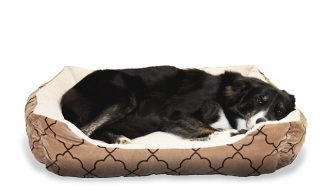Some content may contain affiliate links to products which means we could earn a fee on your purchase. Thank you for visiting
One thing is for certain; as our senior dogs journey through the aging process, they sleep more and more. And as sleep increases, a dog’s need for a comfortable place to rest her arthritic, achy bones becomes paramount to having pain free mobility.
How many dog beds should a dog have? Generally speaking your dog should have a bed available in each location where family members spend time sitting or sleeping. For instance, if some of your family spends several hours watching tv in the living room while others play video games in a family room, then your dog should have a bed available in both rooms. And if that dog sleeps the night in a master bedroom, then add a bed in the master bedroom.
In this example, our dog should have 3 beds, preferably 4 as follows:
- 1 bed for the living room
- 1 bed in the family room
- 1 bed in the master bedroom
- 1 bed for quick replacement during bed laundering
Here is another example answering how many beds should a dog have? A dog lives in a home where he is alone during the day while owners work and go to school. The dog sleeps in the living room during the day and spends the night sleeping in a kid’s room. In this example, our dog should have 2 beds, preferably 3 as follows:
- 1 bed for the living room
- 1 bed in the kid’s room
- 1 bed for quick replacement during bed laundering
Other Factors for Determining Number of Dog Beds
Let’s face it; having dog beds all over the house is not entirely feasible, especially for those of us with large breed dogs. A large breed dog bed can be the size of a small sofa and having one in each room might not be appropriate.
The best guidelines to use for making your dog the most comfortable during his senior years is to offer a comfortable dog bed wherever the family will actually spend time sitting or sleeping. Kitchens, laundry rooms or spare bedrooms where the dog doesn’t sleep are not important places for a dog bed.
For the most part, our dogs like to lie down and sleep wherever we are and you can use his sleeping habits to help decide whether or not multiple beds throughout the home are necessary.
For example: if your dog sleeps on the first floor and never ventures upstairs or downstairs, then one nice, comfortable bed on the main floor plus one alternate bed to use while his main bed is being cleaned should suffice.
Why Not Just Move The Dog Bed Around?
Do you really need all of these dog beds? What if you just moved the same dog bed around to different locations? While that sounds doable in theory, it’s not very realistic that you will remember to move your dog’s bed from one room to another.
Each time you forget to move your dog’s bed, your dog will inevitable end up suffering the effects of her older, achy bones rubbing against, cold, hard flooring. As our dogs get older, it’s hard to get up from the floor and stiffness comes on much more quickly.
On top of that, it’s really not as convenient as it seems. Imagine carrying a sitting chair into each room rather than having one available in each room. Moving your dog’s bed around would soon become a chore.
Why Dogs Should Have Their Own Beds
But my dog sleeps with me, in my bed! That’s great actually, and my dog too has been known to sleep in my bed with me. But as dogs age they change.
They don’t always like getting in bed at the same time, they don’t feel as confident getting up and down from the bed and they will inevitable begin to lose control of their bladder while sleeping.
Our senior dogs are going to go through the same stages as elderly humans and getting them used to their own bed now will help them (and you) in their ageing process.
You can begin now by offering your dog his own bed atop your bed. This way, you’re still (technically) sleeping together. But as he journeys through his senior years and doesn’t want to be high on the bed or begins to have accidents, moving his bed won’t feel like such a big change.
My senior dog (he’s pretty large) stopped sleeping in my bed about a year ago. I made him an awesome big bed right off to the side and he absolutely loves it. I think he actually sleeps better in his own space and when he has an accident, I just launder everything.
I recommend using a cheap mattress protector made for kids beds like this: mattress protector. They absorb the pee, protect the dog bed and are good for several hundred washes.
Alternatively, for a little more, you can get a nice pee blanket that’s made for dogs like this: Pee blankets for dogs.
Overcoming the Expense of Dog Beds
If buying multiple dog beds is cost prohibitive you can absolutely spend less while still providing comfortable bedding to your dog. A little creativity can go a long way when it comes to dog bed ideas. For instance:
- Egg crate mattress toppers can be cut and stuffed inside pillow cases, shams or duvets’ depending on the size of your dog.
- A roll of good, clean foam (product link) is all you need if you’re a skilled sewer. You can probably make 4 amazing dog beds for the price of one.
- Patio furniture cushions regularly go on sale at the end of summer and while $20 may seem expensive for a chair cushion, it’s a deal compared to the price of a dog bed.
- Crib mattresses can be very inexpensive or even free when acquired 2nd hand.
- Your old couch or sofa might have perfect cushions for your dog and sometimes they are the perfect width for a dog crate.
Just remember that the ultimate goal is to make your dog more comfortable by providing bedding throughout the home. If you cannot afford a dog bed, think outside the box and you can do a pretty good job of taking cost right out of the equation.
In Summary
At the very least, provide your dog with one dog bed per room where the family spends time sitting, sleeping or relaxing. In addition, a roll up or portable bed will come in handy for car trips and can also serve as a temporary bed when main bedding is being washed or cleaned.
Get creative and think outside the box if the cost of pre-made dog beds is too much for your family budget to absorb.
The idea is that your dog needs a comfortable seat, just like you do. And even more so as our dog’s age, they need constant cushion between their aching, arthritic bones and the hard, cold floors.
Do dogs really need a bed? Yes, absolutely a dog needs a bed that provides cushion between her pointy bones and the hard flooring – even carpeting.
Think about the last time you sat on a floor for an extended period of time. If you’re over the age of 30, I’m guessing it didn’t feel so good after awhile. Same goes with your aging dog.
How many beds should a dog have? The more options, the better. For more information about how much sleep an older dog needs, CLICK HERE How Much Sleep for Senior Dogs?
If you’re interested in learning which design of dog bed (bolster vs. elevated. vs. flat mat) is suited for your dog you can read this article when time allows: Dog Bed Designs.
And here are some related questions regarding dog beds. They don’t require an entire article but are somewhat related and worth covering.
Related Questions
How to stop my Dog from Lying in front of the stairs? Does your dog sleep at the top or bottom or stairs? You’re not alone! Having a big dog sprawled out in front of a set of stairs can be a dangerous predicament for humans who are trying to use the staircase without injury.
If this is happening in your household, a well-placed dog bed might just alleviate the danger. Often times, placing a cushy bed off to the side will be a welcome addition and your dog will happily oblige moving to the bed, thereby freeing up the bottom or top of the stairs.
If you’re dog rejects the bed, you’ll need to take a phased approach. Place the dog bed where they lay in front of the stairs and then move the bed a foot away each day. Your dog will learn to use the bed and in most cases, grow to prefer it to the cold, hard floor.
Why does my cat sleep in my dog’s bed? Cat’s like warm, comfortable beds and they also like anything new. If you’ve recently purchased a new bed for your dog, it’s very likely that cats will be naturally intrigued with the new addition.
If this is happening in your home, you can usually rectify this by making a smaller, cozier bed for your cat nearby. It doesn’t have to be a new bed. A freshly laundered, fluffy or wooly blanket with the tiniest sprinkle of catnip should be enough to make your cat happy and keep her out of the dog’s new bed.

